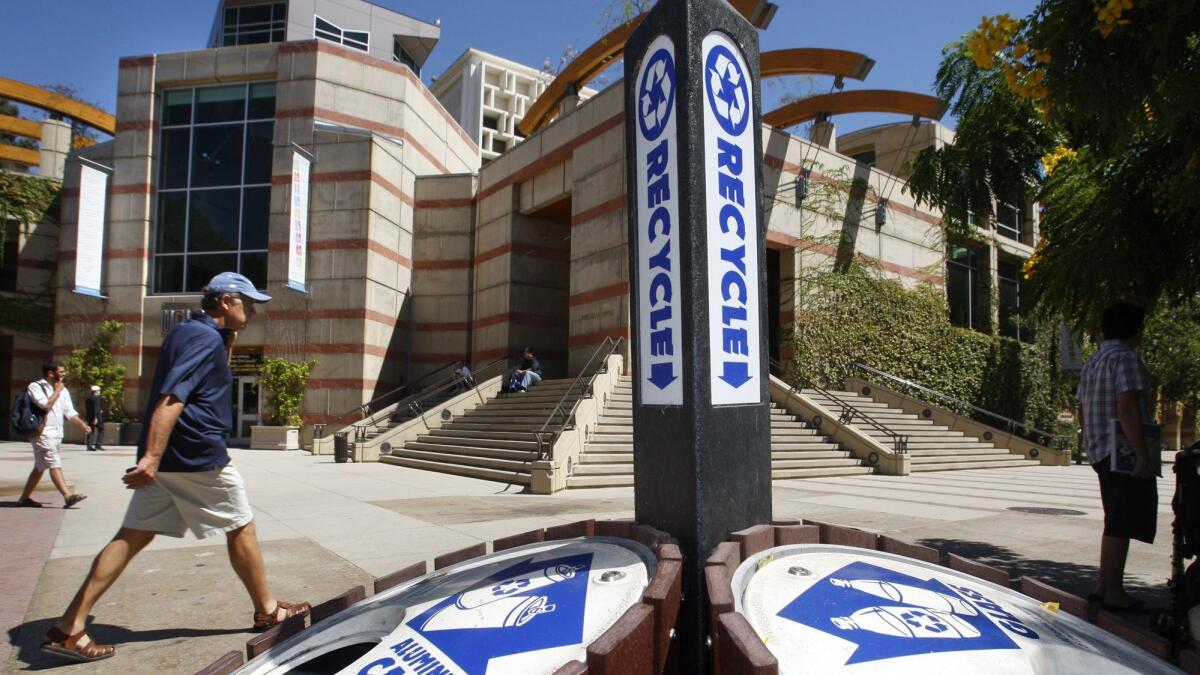Column: Environmentally minded Californians love to recycle — but it’s no longer doing any good

- Share via
Reporting from Sacramento — Californians dutifully load up their recycling bins and feel good about themselves. They’re helping the environment and being good citizens.
But their glow might turn to gloom if they realized that much of the stuff is headed to a landfill.
That’s because there’s no longer a recycling market for a lot of the paper, cardboard, plastic and other junk that’s left curbside.
Moreover, people are tossing garbage into those blue bins that they shouldn’t be. It just gums up the process.
“People are engaged in wish recycling,” says Mark Oldfield, public affairs director at CalRecycle, which runs the state’s recycling program. “They think: ‘This should be recycled. I’m going to put it in the bin.’”
“It’s amazing what people put in recycling bins,” Oldfield continues. “Dirty diapers. Broken crockery. Old garden hoses. Some of the worst offenders are old batteries.”
But what constitutes forbidden material is more nuanced than soiled diapers and corrosive batteries. Oldfield says it includes pizza boxes blotched with cheese and grease, plastic wrappers for food, shredded paper, unclean jelly jars, broken glass, unrinsed bottles and newspapers that have lined bird cages. Even paper envelopes with plastic address windows.
Recyclers these days don’t want items with mixed material such as paper and plastic, or cardboard and tape. It doesn’t pay to tear the stuff apart. Off to the landfill.
Moreover, what used to be California’s — and the world’s — largest overseas market for recyclables recently shut its door.
“China doesn’t want our garbage anymore,” says Steve Maviglio, a political strategist who is advising the recycling industry. “It’s time we cleaned up our own mess.”
In January, China began barring “contaminated” material it once accepted. And under China’s new rules, if something is one-half of 1% contaminated, it’s too impure for recycling.
“This policy change is already starting to have adverse impacts on California,” CalRecycle declared last month in a bulletin, “and is resulting in more material being stockpiled at solid waste facilities and recycling centers or disposed of in landfills.”
Eric Potashner, a government relations official for Recology, a curbside hauler that sorts San Francisco Bay Area trash for recycling, says, “There’s no market for a lot of stuff in the blue bin. What we can’t recycle we take to a landfill.”
One big problem, he says, is mixed paper — newsprint, magazines, junk mail. China no longer wants it. So it’s being sold to smaller markets in India, Vietnam and other Southeast Asian countries. The issue is compounded because, unlike with Chinese vessels, there are fewer ships making round trips from Southeast Asia to California.
“A year ago,” Potashner says, “we were getting $100 a ton for newsprint. Now we’re getting an average $5…. Revenue has fallen off the cliff.”
Mark Murray, executive director of Californians Against Waste, an advocacy group, says: “China’s not the bad guy. To the Chinese credit, they’ve decided they don’t want to have Third World [trash] sorting in their country.”
The Chinese have a growing middle class, Murray continues, and “they don’t want kids and families sorting through mixed paper and plastic. They want to hire factory workers, not people doing the dirty work.”
Collapse of the China market is just the latest recycling problem for California.
There’s continuing struggle with the popular beverage container recycling program that originated with passage of California’s convoluted so-called Bottle Bill 32 years ago.
Under it, people can ostensibly cart their used bottles and cans to a recycling center and collect the nickel apiece — or dime for larger ones — that they deposited when buying the beverage at a store.
Coverage of California politics »
But the program itself needs recycling. It’s not generating enough money, in many cases, to make recycling pay. Scrap value has dropped — especially for plastic. When oil prices tumbled, it became cheaper to make plastic bottles from all-new material than recycled matter.
Nearly 1,000 recycling centers have closed in the last two years, about 40% of the total, leaving consumers in many communities with no local place to leave their bottles and redeem their nickels.
California’s once-proud recycling program “is teetering on the edge,” says state Sen. Steve Glazer (D-Orinda). It was hit hard in 2016 when the state cut back on fees it paid to recyclers. The old fees served as recycling incentives.
Glazer has a modest bill that he says is “better than doing nothing at all.” His measure would return fees to their 2015 level.
That’s a carrot. There’s a stick in a bill by Sen. Bob Wieckowski (D-Fremont). It would require all beverage containers sold in California to contain a minimum amount of recycled material. CalRecycle would establish the minimum.
The bill is particularly aimed at plastic containers. The goal is to establish a bigger market for plastic recycling in California. It also would help reduce greenhouse gases, the senator says, because “we wouldn’t be burning more oil to make plastic bottles.”
Gov. Jerry Brown, in his new state budget, shifted $15 million in bottle bill money to private firm incentives for processing and purchasing recycled plastic.
Nice touches, but they’re Band-Aids.
Consumers — taxpayers — will need to put more into the pot to pay for sustainable recycling and creating a bigger market for California trash.
We’ve got to stop dumping useless, filthy crud in blue bins.
It’s either that or spend more money for ugly landfills.
Follow @LATimesSkelton on Twitter
More to Read
Get the L.A. Times Politics newsletter
Deeply reported insights into legislation, politics and policy from Sacramento, Washington and beyond. In your inbox three times per week.
You may occasionally receive promotional content from the Los Angeles Times.











